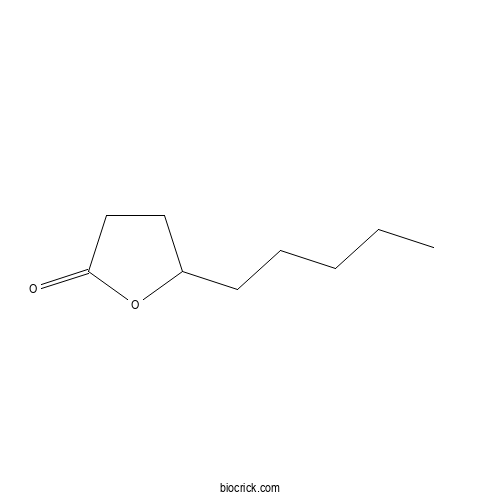gamma-NonanolactoneCAS# 104-61-0 |

Quality Control & MSDS
3D structure
Package In Stock
Number of papers citing our products

| Cas No. | 104-61-0 | SDF | Download SDF |
| PubChem ID | 7710 | Appearance | Powder |
| Formula | C9H16O2 | M.Wt | 156.2 |
| Type of Compound | Miscellaneous | Storage | Desiccate at -20°C |
| Solubility | Soluble in Chloroform,Dichloromethane,Ethyl Acetate,DMSO,Acetone,etc. | ||
| Chemical Name | 5-pentyloxolan-2-one | ||
| SMILES | CCCCCC1CCC(=O)O1 | ||
| Standard InChIKey | OALYTRUKMRCXNH-UHFFFAOYSA-N | ||
| Standard InChI | InChI=1S/C9H16O2/c1-2-3-4-5-8-6-7-9(10)11-8/h8H,2-7H2,1H3 | ||
| General tips | For obtaining a higher solubility , please warm the tube at 37 ℃ and shake it in the ultrasonic bath for a while.Stock solution can be stored below -20℃ for several months. We recommend that you prepare and use the solution on the same day. However, if the test schedule requires, the stock solutions can be prepared in advance, and the stock solution must be sealed and stored below -20℃. In general, the stock solution can be kept for several months. Before use, we recommend that you leave the vial at room temperature for at least an hour before opening it. |
||
| About Packaging | 1. The packaging of the product may be reversed during transportation, cause the high purity compounds to adhere to the neck or cap of the vial.Take the vail out of its packaging and shake gently until the compounds fall to the bottom of the vial. 2. For liquid products, please centrifuge at 500xg to gather the liquid to the bottom of the vial. 3. Try to avoid loss or contamination during the experiment. |
||
| Shipping Condition | Packaging according to customer requirements(5mg, 10mg, 20mg and more). Ship via FedEx, DHL, UPS, EMS or other couriers with RT, or blue ice upon request. | ||
| Description | gamma-Nonanolactone is an aroma component of steamed wheat. | |||||

gamma-Nonanolactone Dilution Calculator

gamma-Nonanolactone Molarity Calculator
| 1 mg | 5 mg | 10 mg | 20 mg | 25 mg | |
| 1 mM | 6.402 mL | 32.0102 mL | 64.0205 mL | 128.041 mL | 160.0512 mL |
| 5 mM | 1.2804 mL | 6.402 mL | 12.8041 mL | 25.6082 mL | 32.0102 mL |
| 10 mM | 0.6402 mL | 3.201 mL | 6.402 mL | 12.8041 mL | 16.0051 mL |
| 50 mM | 0.128 mL | 0.6402 mL | 1.2804 mL | 2.5608 mL | 3.201 mL |
| 100 mM | 0.064 mL | 0.3201 mL | 0.6402 mL | 1.2804 mL | 1.6005 mL |
| * Note: If you are in the process of experiment, it's necessary to make the dilution ratios of the samples. The dilution data above is only for reference. Normally, it's can get a better solubility within lower of Concentrations. | |||||

Calcutta University

University of Minnesota

University of Maryland School of Medicine

University of Illinois at Chicago

The Ohio State University

University of Zurich

Harvard University

Colorado State University

Auburn University

Yale University

Worcester Polytechnic Institute

Washington State University

Stanford University

University of Leipzig

Universidade da Beira Interior

The Institute of Cancer Research

Heidelberg University

University of Amsterdam

University of Auckland

TsingHua University

The University of Michigan

Miami University

DRURY University

Jilin University

Fudan University

Wuhan University

Sun Yat-sen University

Universite de Paris

Deemed University

Auckland University

The University of Tokyo

Korea University
- Furfuryl alcohol
Catalog No.:BCN9733
CAS No.:98-00-0
- Carvacryl acetate
Catalog No.:BCN9732
CAS No.:6380-28-5
- Rauhimbine
Catalog No.:BCN9731
CAS No.:66634-44-4
- 11-Oxomogroside IIIE
Catalog No.:BCN9730
CAS No.:2096516-68-4
- 4-(2,6,6-Trimethyl-1-cyclohexenyl)-3-buten-2-one
Catalog No.:BCN9909
CAS No.:79-77-6
- Artanomaloide
Catalog No.:BCN9728
CAS No.:112823-41-3
- Phyllanthurinolactone
Catalog No.:BCN9727
CAS No.:168180-12-9
- Pumiloside
Catalog No.:BCN9726
CAS No.:126722-26-7
- Rossicaside B
Catalog No.:BCN9725
CAS No.:80458-55-5
- Stephodeline
Catalog No.:BCN9724
CAS No.:56596-12-4
- O-Methylmurrayamine A
Catalog No.:BCN9723
CAS No.:134779-20-7
- N-Methoxy-3-formylcarbazole
Catalog No.:BCN9722
CAS No.:117592-01-5
- 1-(3',5'-dimethoxy)phenyl-2-[4''-O-beta-D-glucopyranosyl (6->1)-O-alpha-L-rhamnopyranosyl]phenylethane
Catalog No.:BCN9735
CAS No.:1338076-61-1
- Tripalmitin
Catalog No.:BCN9736
CAS No.:555-44-2
- Capsanthin
Catalog No.:BCN9737
CAS No.:465-42-9
- Uzarin
Catalog No.:BCN9738
CAS No.:20231-81-6
- Ethyl 3-hydroxybenzoate
Catalog No.:BCN9739
CAS No.:7781-98-8
- Clausine E
Catalog No.:BCN9740
CAS No.:182261-83-2
- Quercetin 3,4'-diglucoside
Catalog No.:BCN9741
CAS No.:29125-80-2
- 1-(2-Hydroxyphenyl)-3-phenyl-2-propenone
Catalog No.:BCN9742
CAS No.:1214-47-7
- Betonicine
Catalog No.:BCN9743
CAS No.:515-25-3
- (+)-atechin 5-gallate
Catalog No.:BCN9744
CAS No.:128232-62-2
- Hibifolin
Catalog No.:BCN9745
CAS No.:55366-56-8
- 2-Naphthol
Catalog No.:BCN9746
CAS No.:135-19-3
Analysis of the Volatile Components in Selaginella doederleinii by Headspace Solid Phase Microextraction-Gas Chromatography-Mass Spectrometry.[Pubmed:31892247]
Molecules. 2019 Dec 27;25(1). pii: molecules25010115.
Selaginella doederleinii (SD) is a perennial medicinal herb widely distributed in China. In this study, the volatile components of SD from two regions (24 batches), namely Zhejiang and Guizhou, were determined by combining headspace solid phase microextraction and gas chromatography-mass spectrometry (HS-SPME/GC-MS). After investigating different influence factors, the optimal conditions for extraction were as follows: The sample amount of 1 g, the polydimethylsiloxane-divinylbenzene (PDMS-DVB) fiber of 65 microm, the extraction time of 20 min, and the extraction temperature of 100 degrees C. Based on the above optimum conditions, 58 volatiles compounds, including 20 terpenes, 11 alkanes, 3 alcohols, 6 ketones, 3 esters, 11 aldehydes, 1 ether, 1 aromatic, 1 phenol, and 1 furan, were found and identified in SD. Furthermore, hierarchical cluster analysis and principal component analysis were successfully applied to distinguish the chemical constituents of SD from two regions. Additionally, anethol, zingerone, 2,4-di-tert-butylphenol, ledene, hexyl hexanoate, alpha-cadinol, phytone, hinesol, decanal, octadecene, cedren, 7-tetradecene, copaene, beta-humulene, 2-butyl-2-octenal, tetradecane, cedrol, calacorene, 6-dodecanone, beta-caryophyllene, 4-oxoisophorone, gamma-Nonanolactone, 2-pentylfuran, 1,2-epoxyhexadecane, carvacrol, n-pentadecane, diisobutyl phthalate, farnesene, n-heptadecane, linalool, 1-octen-3-ol, phytane, and beta-asarone were selected as the potential markers for discriminating SD from 24 habitats in Zhejiang and Guizhou by partial least squares discrimination analysis (PLS-DA). This study revealed the differences in the components of SD from different regions, which could provide a reference for the future quality evaluation.


